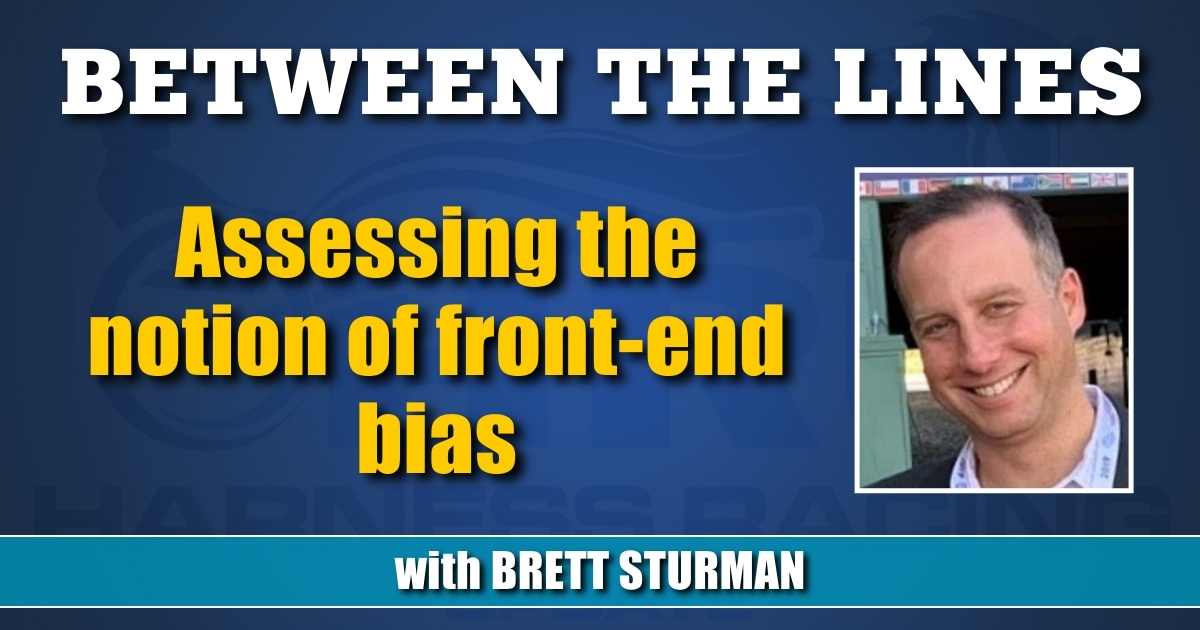Assessing the notion of front-end bias…
… and what the sport can do to diminish it.
by Brett Sturman
Through a prominent driver and a separately prominent trainer, this column has recently touched on the idea of an ever-expanding speed bias in harness racing. At its core, the logic is that horses are faster than ever before, carry their speeds longer, and so it has become extensively more difficult for horses to win from off the pace.
I think that most would accept that premise as more or less correct, including myself. But the fact that horses on the front or ones that race close to the front win more races is not something new; it has always been like that to some degree. When speaking of bias, there is a bias to begin with in harness racing that the better horses traditionally race near the front to begin with. Most times, the race favorites are forwardly placed, so of course it’s going to be those horses that are even more likely to win. For example, it seems like every other race at Monticello the track announcer says, “And at the quarter pole, the favorites are running 1-2.” Of course they are. It’s not happening by accident. In these cases, the bias just as much as anything else is that the better horses are put in more advantageous positions than lesser horses to start with.
The bias is evident even on mile tracks such as the Meadowlands. It’s one thing for the favorites to continuously line up on a half-mile track which makes it almost certain no one will come from off the pace to win, but that type of thing isn’t supposed to happen on the big tracks.
Fortunately, I’d say that there are ways to combat the bias and have races run fairer. It’s a simple concept, too. If there is more early action in races and more aggressive racing tactics are adopted, there won’t be as many races where it’s impossible for most horses to win halfway through the race. Such was the case at the Meadowlands not too long ago. Even if you buy into the thought that horses carry their speed longer now than they did 20 years ago, the fact remains that 20 years ago at the Meadowlands you could be in first at the quarter and then 10th by the half. Almost never will you see that type of early shuffle today at the Meadowlands, or anywhere else for that matter.
Without that type of action and horses left to stroll along at their own will, of course it’s difficult for horses to win from off the pace; especially when coming from off the pace and ceding even further ground when racing wide. But in races where there is activity, it becomes a different story. This can be illustrated to a degree by looking at the last three nights of racing from the Meadowlands (the last two Fridays and last Saturday).
Beginning with Friday, Feb. 19, nine of the 13 races were won by horses on the front, or close to the front by the half-mile mark. In these races, horses were able to be put on the lead fairly comfortably or race up close without expending much energy to be in those positions. In one race that night, a 27-1 horse, Shady McCoy, juked off second-over cover to fair and square overcome the typical bias in a race where the leader tired in the waning stages to finish fourth. There were three other races that weren’t won on or close to the front, and in one of those the leader was hard used from post 10 and tired, which set the race up for a 22-1 winner. In another, the leader folded approaching the stretch setting up for the closers which was one by Betalady who surged four-wide at three-quarters, though admittedly she would have been good enough to track down anyone regardless. Another race was won by a 30-1 longshot who never left the inside, found a lane in the stretch and simply had more trot than the tepid favorite who raced on the lead.
Last Saturday the results were similar. In 15 races, by my account 12 of those were won on or close to the front and without the need to race off cover. One exception was the first race, won by a 37-1 horse from post 1 who never left the rail and was able to squeeze up the inside in the stretch in a race where the 3-5 favorite was empty. Race 8 that night saw the even money favorite Gods Spirit N win from a second-over trip where leader had it is own way the front, and race 14 saw Lyons Steel win while making a three-wide move, though in that race the leader had to park out a challenge through a :27.1 second panel.
This past Friday did see more horses winning from off the pace, though most of those races included more movement in the race. The exception to that was in the first race in which a 12-1 chance with Steve Smith tipped off third over cover and tracked down the odds-on favorite that had clear separation. But race two that night was a clear example of what can happen when multiple horses make moves to the front. In that race, there were four lead changes in the first three-eighths and the race set up for the outer flow. Also, that night was another huge rally from Betalady, just as the Friday prior. When you’re that good it doesn’t matter where you’re coming from.
The takeaway from all this is that the more action in a race, the less of a bias there will be. If every race happened to be a GSY Amateur Series race as was the case from the second race on Friday where horses are raced perhaps less cautiously than other races, would there really be as many uncontested leads and one-minute middle fractions? It’s not to say that every race needs to be the wild west, but normal racing used to be more aggressive than it is today.
Also, if there is an acknowledgement of the importance of having to race on or close to the front, why aren’t there greater pushes or challenges when horses try to get there? Most times the lead is often ceded without much fight, cozy tucks are (not strategically) provided, and the best drivers are often free to do what they want. You’d think with being close-up as a critical component to win, that there should be fights to gain those positions.
Horses are already more capable than they’ve been of utilizing front-end positioning as a means to win. But it can be combatted by a return to a less passive style of racing.
















